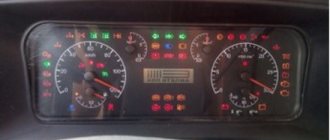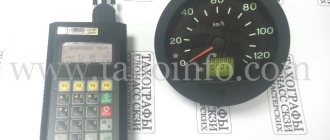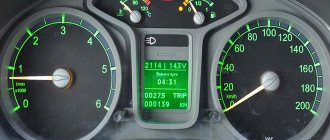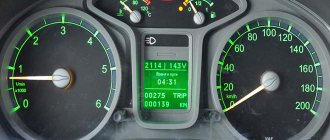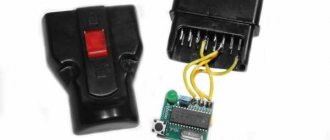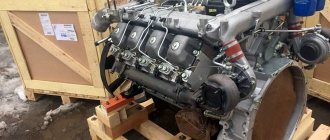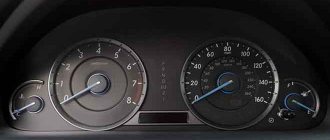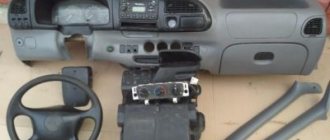Device
The speedometer on KamAZ is a device for measuring the speed of a vehicle. The device connects to a speed sensor and a topographer.
- Pointer - speed is shown by moving the arrow across the dial.
- Tape - the location of the tape on the horizontal scale shows the speed.
- Drum - the indicator is placed on a drum that rotates in proportion to the change in speed.
A mechanical dial meter is installed on many machines.
Analog meter device:
- Worm unit, which is installed in the gearbox.
- A gear that rotates together with the gearbox shaft. This makes it possible to calculate the rotation speed of the drive and wheels.
- The wire that runs from the worm assembly to the instrument panel.
- Magnetic element.
- A metal plate attached to the arrow.
- Scale.
- Spring.
An accompanying element of the device is a counter, which determines the length of the path traveled and is connected to the cable via a worm gear.
In the electronic device, there is no mechanical connection between the data on the instrument panel and the transmission output shaft. The device is:
- Optoelectronic, in which there is a high-speed part with a cable, and the speed data is determined by photointerrupter pulses.
- Bestrosov, in which a magnet is installed, rotating in place with the gearbox shaft. Changes in the magnetic field are converted into pulses by the bridge circuit.
A popular meter that operates using the Hall effect. Changes in output voltage are proportional to the rotation speed of the disk. The frequency of the voltage pulses allows you to determine the speed of the machine.
How to fool a digital tachograph
It is impossible to give a definite answer to this question. In the device menu there is a subsection “Events and errors”, in which failures, malfunctions and shutdowns of the device are recorded. All information can be printed. It states whether the battery was removed, whether the vehicle was used without a driver card, and also records the time intervals of exceeding the speed limit and work schedule. The following types of intervention are recorded in the equipment:
- impact of a magnet on the speed sensor;
- disconnecting power from the battery;
- turning off the ignition wires;
- disabling the speed sensor.
All information is recorded in the internal memory of the device. It is impossible to influence the ability to disable recording of events and errors in digital monitoring devices, which is why such models are most preferable for installation. In addition, connecting via a channel allows the tachograph to exchange information with the on-board computer. Disabling the device causes dashboards to malfunction and may not display speed and other important metrics correctly.
The device must contain:
- electronic map and motion sensor;
- GPS and GLONASS receiving modules;
- GSM/GPRS reception antennas;
- seals on the case, anti-burglary design;
- cryptographic protection and related software;
- availability of sensors and warning devices.
Prices for tachograph cards can be found here!
Important information about discrepancies with the navigation system, satellite and sensors is displayed in the non-volatile memory of the device. There is no point in trying to find ways on the forum to deceive the tachograph. Recorded data cannot be changed. They are recorded digitally using complex cryptographic encryption algorithms. The integrity of the information is controlled by the data security module. The use of faulty equipment is prohibited and is fraught with hefty fines. Some drivers advise using special anti-tachographs that leave no traces of interference in the system memory. They are not suitable for digital models.
Why does not it work
If the speedometer fails or does not work, the reasons may be as follows:
- The gears of the worm gear of the device are made of plastic. Since the material is fragile, this can cause the gears to break.
- The cable broke off where it connects to the speed system, which is screwed into the gearbox.
- The sensor contacts have oxidized or the power supply wire has broken. At the same time, the power is checked using a multimeter.
- There was a breakdown of the electronic part of the device located in the panel.
- There were distortions in the device readings. Most often this is due to instrument calibration, which is difficult to perform.
Speed is measured by the rotation of one axle of the final drive, and when turning, the wheel located on the inner radius travels a shorter distance than the outer one.
But the main reason for the inaccuracy of the data is the size of the wheels. The larger the wheel, the greater the distance the machine will travel in 1 revolution of the shaft.
The meters are mistaken by 5-10 km/h. Sometimes inaccurate data causes accidents. Therefore, car manufacturers, when calibrating electronic devices, make sure that the device on a new car does not show an underestimated speed.
How to connect
The speedometer connection diagram, calibration and pinout instructions are available in the operating instructions for the device. At KamAZ, during manufacturing, the device is configured and a seal is installed on it. The need for adjustment arises when replacing a sensor, dump semi-trailer, wheels, axles.
The speedometer setting is as follows:
- KPPS is determined (coefficient of the speedometer indicating device);
- the value of the maximum speed is adjusted;
- the current time is adjusted.
KamAZ speedometers cannot be repaired. Their disassembly leads to malfunction. The meter is replaced by specialists.
If seals, connecting wires, or sensors have been broken, the warranty service of the device is terminated.
Seals are installed at the manufacturer.
KamAZ speed sensor pinout
The speed sensor affects the amount of fuel supplied, as well as the amount of air that flows past the throttle valve. All these factors will affect the speedometer readings, therefore, for its connection and further proper operation, it must be carried out strictly in accordance with the diagram.
Pinout is a digital designation of connector functions, necessary for the correct order of connecting various parts and cables.
Modern KamAZ models, for example, 65115, are powered by Euro-3, Euro-4 and Euro-5 engines. Trucks with such engines are most often equipped with contact sensors located at the gearbox. The sensors on KamAZ of the Euro series are recognized as the most reliable in comparison with other models.
The principle of operation of the speed sensor is based on the supply of an impulse from the rotating wheels, which, when entering the device, is converted and, through the clutch with the speedometer, displays a certain numerical value on the LCD.
If the speed sensor is faulty, there may be problems with the engine idling, the car may not. In this case, the gearbox and speed sensor need to be replaced. You can independently configure the speedometer and motion sensor only in accordance with the pinout:
Description of DS
As we have already said, the main purpose of the speedometer drive sensor is to accurately determine the speed of the vehicle. Thanks to this device, the model can always know at what speed his car is moving. As for the varieties, DS can be of the contact or non-contact type. Today, most of our compatriots prefer contactless options. Contact DS, despite all the advantages, have one significant drawback - they are prone to contamination, which in turn will lead to inaccuracy of the displayed readings.
Design and principle of operation
Structurally, according to the diagram, this part consists of:
- speedometer drive;
- housings;
- as well as the controller itself with a connector for connecting to the on-board network.
As for the principle of operation, it is based on measuring the frequency level of signals from the controller, which is located on the gearbox housing or transfer case. At the output of the device, while driving, rectangular pulses are formed, the minimum value of which should be at least 1 volt, and the maximum value should be at least 5 volts.
Speedometer functions
The sensor is primarily connected to the speedometer. For this reason, you need not only to know where the KamAZ speed sensor is located, to carefully monitor its serviceability, but also to take into account the functionality:
- speed measurement and display;
- displaying information about the distance traveled;
- informing about the current time;
- alarm about exceeding the permissible speed;
- measurement of the number of pulses for correct reading of characteristics.
Speed sensors on KamAZ 43118 vehicles and other models must be operational for safe driving, both in the city and on the highways.
Connection
Connecting a revolution counter to a Kamaz vehicle generator is quite simple. To do this you will need:
- The tachometer itself.
- Copper wire with dense insulation, cross-section of at least 4 mm.
Next, the connection is made according to the following scheme:
- Remove the generator protective casing.
- Connect one end of the prepared wire to the ~ terminal on the generator.
- Connect the second end of the wire to the ~ terminal on the device itself.
- Connect the “+” terminal on the tachometer to the “+” output from the fuse box.
- The minus terminal of the tachometer can be fed to the housing by firmly connecting it with a bolt.
Older generators often do not have the ~ (W) terminal. To connect, you will have to dismantle the generator, remove the boot and find 3 twists connecting the winding into a solid circuit. A wire from the ~ terminal of the device can be connected to any of these connections. It is important that the wire connection is secured by soldering, and that the gasket in the generator itself does not create a break or short circuit due to contact with the rotating elements of the mechanism.
Tachometers are also equipped with a backlight lamp. It must be connected to the ambient light switch.
Important! On older model cars, the “+” terminal from the tachometer goes directly to the “+” contact with the least load. In new models this connection has been significantly changed. The “+” contact is connected directly to the same terminal, only on the speedometer. In this way, the backlight of both devices is turned on synchronously, as well as power from the electric drives.
You can connect analog and digital devices in this way. Particular attention should be paid to the “+” contact. It must be connected after a fuse with a rating of at least 10A. This will help protect the device from electrical overloads and short circuits. Above is a diagram of connecting a tachometer to the electrical circuit of a Kamaz vehicle.
How to wind the speedometer on a KamAZ
The KamAZ-6520 or KamAZ Euro speedometer is adjusted using special devices that allow you to adjust the device’s performance. If you need to rewind the device or change the device data, you can contact specialists. But there is a way to do it yourself.
KamAZ is equipped with a speedometer and odometer, showing the mileage of the vehicle, and has a generator and engine system. The generator is the sensor, the engine is the receiver. The speedometer receives a three-phase signal from the generator.
The winding circuit of the device should create a similar three-phase signal with a 120° shift between phases. To change the data on the number of kilometers, you need to change the numbers not only on the speedometer, but also on the odometer. A device for winding measuring devices (twist, winder or winder) carries out such actions automatically. When twisting, the changed data of the electronic speedometer and all other electronic units are saved.
Examination
The main test is the pulse voltage test with the engine running. To do this you need:
- Set the tester to DC voltage measurement mode.
- Connect the red multimeter probe to the ~ terminal of the generator.
- Connect the black test lead to ground.
A working generator should produce pulsed voltage values from 12 to 24 volts.
The test can also be carried out using an LED light bulb. Its anode (long leg) is connected to the ~ (sometimes designated as W) terminal of the generator, and the cathode to ground. The light should blink if the generator is producing frequency voltage.
This method checks the presence of pulse signals coming from the electrical generator itself. To check the operation of the device itself, you need to apply 12 volts to the ~ terminal. Voltage is supplied by intermittent touches. The arrow should react abruptly. If this does not happen, the device is considered unfit for use.
Features of electrical equipment
Now let's move on to the description of the KAMAZ electrical circuit.
All models of KAMAZ 6520, 55102 and other trucks are equipped with the following subsystems:
- Starting the power unit.
- Turning lights and hazard warning lights.
- Heating unit, power supply system, windshield cleaning mechanism.
- Vehicle interior lighting.
- Head lighting. It includes low and high beam headlights, fog lights if they are installed on the car, brake lights, and dimensions.
- Tidy. This node is considered one of the main ones in the on-board network, since it contains the main sensors, devices and instruments, including a tachometer, speedometer, fuel level sensor, etc. In addition, the control panel has light indicators that turn on when the lighting is activated , handbrake, etc. Thanks to the indicators, the driver can indirectly determine the status of some components.
- Vehicle anti-theft system, if installed.
- Fuse block. This component protects the car's electrical circuits from possible voltage surges. It contains fuses responsible for the operation of the main electrical equipment.
- A control unit, thanks to which the normal operation of the main units and equipment of the car is guaranteed.
- Audio system, if the car is equipped with one.
Do-it-yourself rewinding of the KamAZ electronic speedometer
The need to rewind the speedometer arises when you need to change the dashboard or engine. Winding should be done on all parts of the speedometer at once: the odometer measures mileage, the tachometer shows speed. You can only rewind the speedometer readings using a special device that will help you fine-tune all the indicators.
Different types of speedometers work in conjunction with certain sensors, for example, PPS 87.3802 is designed to work with speed sensors 4202.3843, and is suitable for the following KamAZ models: 4310, 5510, 55102, 53212, 43118, 5350 and others.
Electronic speedometers operate thanks to a three-phase signal coming from the generator. A special device - “winder”, “twist” - automatically winds the speedometer and odometer.
To adjust the speedometer, do you turn to specialists or do it yourself?
Source
Connecting the control unit to cars with a mechanical speedometer.
When installing the control unit in cars with a mechanical speedometer, it is necessary to install a pulse speed sensor in the gearbox and replace the mechanical speedometer with an electronic one.
In this case, the input of the electronic speedometer is connected to output “B7” of the control unit. The output of the speed sensor is normally connected to the control unit. The number of pulses at output “B7”, necessary for normal operation of the speedometer, is programmed in the control unit in the “Calibration” mode.
The figure shows a standard European speedometer with connector: ISO 16844-2:2011 (same as on the KU). Speedometers with other types of connectors are connected in the same way, depending on the purpose of the contacts.
In the KU with versions AVLG816.00.00-10...15 (serial numbers No. 4, the output stage B7 was connected to the on-board power supply (12 or 24 V) through a resistor. Therefore, before connecting, you should check the technical data sheet for the speedometer what signal level is acceptable at the corresponding speedometer input.
If the Input is designed for a voltage of no more than 9.5 V, then a resistor Rs* should be connected (shown in the diagram). Select the resistor value according to Table 2. For KU versions AVLG 816.00.00-16 and higher (serial/factory numbers from No. 000 and higher), there is no need to install an additional resistor.
Table 2.
| Element | Rating at Vcc=12 V | Nominal Vcc=24 V | Note |
| Rs | 15 kOhm±10% 0.125 W | 3.3 kOm±10% 0.125 W | Voltage divider resistor. |
